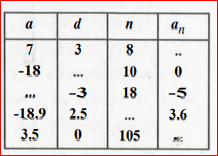In which of the following situations, does the list of numbers involved make an arithmetic progression, and why ? :- The amount of air present in a cylinder when a vacuum pump removes 14 of the air remaining in the cylinder at a time.Solution in Punjabi
The correct Answer is:not form AP
Step by step video, text & image solution for In which of the following situations, does the list of numbers involved make an arithmetic progression, and why ? :- The amount of air present in a cylinder when a vacuum pump removes 1/4 of the air remaining in the cylinder at a time. by Maths experts to help you in doubts & scoring excellent marks in Class 10 exams.
Topper's Solved these Questions
- BOOK - SWAN PUBLICATIONCHAPTER - ARITHMETIC PROGRESSIONSEXERCISE - Exercise 5.226videos
ARITHMETIC PROGRESSIONS
- BOOK - SWAN PUBLICATIONCHAPTER - ARITHMETIC PROGRESSIONSEXERCISE - Exercise 5.335videos
ARITHMETIC PROGRESSIONS
- BOOK - SWAN PUBLICATIONCHAPTER - AREAS RELATED TO CIRCLES EXERCISE - EXERCISE 12.314videos
AREAS RELATED TO CIRCLES
- BOOK - SWAN PUBLICATIONCHAPTER - CIRCLESEXERCISE - Exercise 10.213videos
CIRCLES
Similar Questions
Fill in the blanks in the following table, given that a is the first term, d the common difference and an the nth term of the AP:
 .01:54View Solution
.01:54View SolutionFind the sum of the following APs :- 2, 7, 12, ... to 10 terms.
04:12View SolutionFind the area of the shaded region in Fig., if PQ = 24 cm, PR = 7 cm and O is the centre of the circle.
 02:29View Solution
02:29View SolutionFrom a point Q, the length of the tangent to a circle is 24 cm and the distance of Q from the centre is 25 cm. The radius of the circle is
04:07View SolutionIn which of the following situations, does the list of numbers involved make an arithmetic progression, and why?
(i) The taxi fare after each km when the fare is Rs 15 for the first km and Rs 8 for each additional km.
(ii) The amount of air present in a cylinder when a vacuum pump removes 1/4 of the air remaining in the cylinder at a time.
(iii) The cost of digging a well after every metre of digging, when it costs Rs.150 for the first metre and rises by Rs. 50 for each subsequent metre.
(iv) The amount of money in the account every year, when 10000 is deposited at compound interest at 8 % per annum.04:07View SolutionIn which of the following situations, does the list of numbers involved make arithmetic progression, and why ? (i) The taxi fare after each km when the fare is 15 Rs for the first km and Rs. 8 for each additional km. (ii) The amount of air present in a cylinder when a vacuum pump removes 1/2 of the air remaining in the cylinder at a time.
02:56View SolutionThe amount of air present in the cylinder when a vacuum pump removes each time 14 of the Air remaining in the cylinder. Will the sequence form an A.P. ?
02:46View Solutionक्या किसी बेलन में उपस्थित हवा का आयतन , जबकि वायु - निष्कासक पम्प प्रत्येक बार बेलन की शेष हवा का 14 भाग निकाल देता हैं , A.P. में हैं ?
04:27View Solutionनिम्नलिखित स्थितियों में से किन स्थितियों में सम्बन्ध संख्याओ की सूचि A.P. है और क्यों?
(ii ) किसी बेलन (cylinder ) में उपस्थित हवा की मात्रा,जबकि वायु निकालने वाला पम्प प्रत्येक बार बेलन
की शेष हवा का 14 भाग बाहर निकल देता है|04:06View SolutionIn which of the following situations, does the list of numbers involved make an arithmetic progression, and why?
(iv) The amount of money in the account every year, when Rs. 10000 is deposited at compound intrest at 8% per annum.04:29View SolutionIn which of the following situations, does the list of numbers involved make arithmetic progression, and why ?
The amount of money in the account every year, when Rs.10,000 is deposited at compound interest at 8% per annum.02:04View SolutionWhich of the following situations gives the parallelogram and why? The quantities of gas that remain if a vacuum air exhaust emits about 1/4 of the gas in each cylinder.
12:13View Solutionఒక వాక్యూమ్ పంపు సిలిండరులో ఉండే గాలి నుంచి 14 వంతు తీసివేయును. అయిన ప్రతిసారీ సిలెందరులో మిగిలి వుండే గాలి పరిమాణము.
15:30View SolutionIn which of the following situations, does the list of numbers involved make an arithmetic progression, and why?
(ii) The amount of air present in a cylinder when a vacuum pump removes 1/4th of the air remaining in the cylinder at a time.04:10View SolutionIf they are in G.P.Write next one terms.
1/2, 1/4, 1/8,…….10:25View SolutionIn which of the following situations, does the list of numbers involved form an arithmetic progression, and why?
(i)The taxi fare after each km when the fare is Rs 15 for the first km and Rs 8 for additional km.
(ii) The amount of air present in a cylinder when a vacuum pump removes (14)th of the air remaining in the cylinder at a time.
(iii) The cost of digging a well, after every metre of digging, when it costs 150 for the first metre and rises by 50 for each subsequent metre.
(iv) The amount of money in the account every year, when 10000 is deposited at compound interest at 8 % per annum.12:13View Solution

